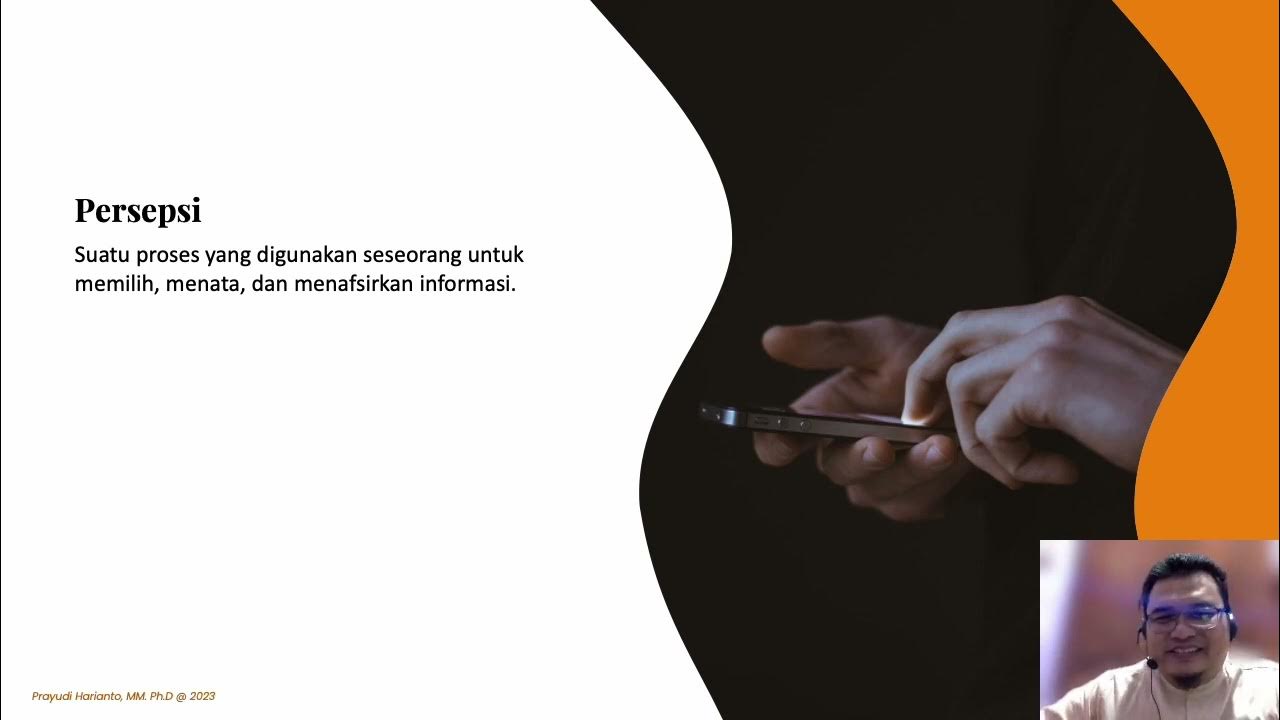Persepsi Konsumen
Summary
TLDRIn this lecture, Puspa Novitasari introduces the topic of consumer perception and image, emphasizing how individuals interpret visual stimuli differently based on their background, knowledge, and expectations. She discusses how perception is subjective and influenced by both internal factors (like psychological needs, personality, and past experiences) and external factors (such as product packaging and environment). She also explains how perception forms consumer attitudes and affects purchasing decisions. The lecture concludes by highlighting the role of perception in shaping brand image and consumer behavior.
Takeaways
- 🎨 Perception is the process where the brain interprets and organizes sensory stimuli into meaningful forms.
- 👀 People can interpret the same visual stimuli in different ways, as shown by the optical illusion in the script.
- 🧠 Perception is subjective, influenced by individual background, experience, and expectations.
- 👥 Consumer perception is shaped by both internal factors (like psychology and experience) and external factors (like environment and product presentation).
- 🍫 Internal factors like stress, education, and personality can influence a consumer's choices (e.g., stressed people may choose comfort foods).
- 📦 External factors such as packaging, advertising intensity, and store environment also play key roles in shaping consumer perception.
- 💡 Perception isn't always aligned with objective reality, meaning people might perceive a product differently than its actual qualities.
- 📈 Positive perception of a product or brand can lead to higher sales and brand loyalty.
- 🏷️ Brand image (or 'Citra') is a consumer’s overall perception of a brand, built over time through experiences and marketing.
- 💬 Perception and brand image are crucial in shaping consumer purchasing decisions and are influenced by how a product is marketed and presented.
Q & A
What is the main topic discussed in this lecture?
-The lecture focuses on perception and image in consumer behavior, explaining how consumers interpret stimuli and how it affects their decision-making process.
How does perception influence consumer behavior according to the lecture?
-Perception influences consumer behavior by affecting how individuals interpret stimuli from their environment, which in turn shapes their purchasing decisions. A consumer’s perception of a product may differ from its objective reality.
What is the relationship between perception and image in marketing?
-Perception forms the basis for building a brand’s image. A consumer’s perception of a product or company—whether positive or negative—directly shapes the brand’s image and influences purchasing behavior.
How can consumers perceive the same product differently?
-Consumers may perceive the same product differently based on factors like their personal experiences, background knowledge, psychological state, and the context in which they encounter the product.
What are internal factors that influence consumer perception?
-Internal factors include psychological needs, education, sensory and nervous system responses, personality, experience, and self-acceptance. These factors impact how consumers interpret and react to products.
What are some external factors that influence consumer perception?
-External factors include the object being perceived, the intensity of stimuli, the environment, and the strength of the stimuli. For example, attractive packaging or a loud advertisement can draw more attention.
Can you give an example of how perception can be subjective?
-Yes, the lecture presents an optical illusion image where some viewers may see a face, while others see a painter in nature. This shows how different individuals can interpret the same visual information differently.
What are the three stages of the perception process described in the lecture?
-The three stages of perception are exposure, attention, and interpretation. Consumers first encounter stimuli, then focus on specific elements, and finally interpret the meaning based on prior knowledge and context.
How does a brand’s image impact consumer decisions?
-A brand's image, shaped by consumers' perceptions, affects whether they choose that brand. Positive perceptions—such as trust in product quality—can lead to a favorable brand image, increasing the likelihood of purchase.
What role do sensory stimuli play in the consumer perception process?
-Sensory stimuli, such as visuals, sounds, smells, and textures, are the initial triggers that consumers experience. These stimuli are processed by the senses and play a crucial role in shaping the consumer’s perception and behavior.
Outlines

Cette section est réservée aux utilisateurs payants. Améliorez votre compte pour accéder à cette section.
Améliorer maintenantMindmap

Cette section est réservée aux utilisateurs payants. Améliorez votre compte pour accéder à cette section.
Améliorer maintenantKeywords

Cette section est réservée aux utilisateurs payants. Améliorez votre compte pour accéder à cette section.
Améliorer maintenantHighlights

Cette section est réservée aux utilisateurs payants. Améliorez votre compte pour accéder à cette section.
Améliorer maintenantTranscripts

Cette section est réservée aux utilisateurs payants. Améliorez votre compte pour accéder à cette section.
Améliorer maintenantVoir Plus de Vidéos Connexes

Meaning of Perception, perception process, perceptual process, ob, organisational behaviour,

Prayudi Harianto, MM., Ph.D - Persepsi dan Pengambilan Keputusan Individual

PSY1004 Week 4 Hale ÖGEL BALABAN - Attention and Perception Part 1

PERSEPSI VISUAL SEBAGAI PROSES PSIKOLOGIS

Sensori, Atensi dan Persepsi

Top Down Processing vs Bottom Up Processing (Examples!)
5.0 / 5 (0 votes)
